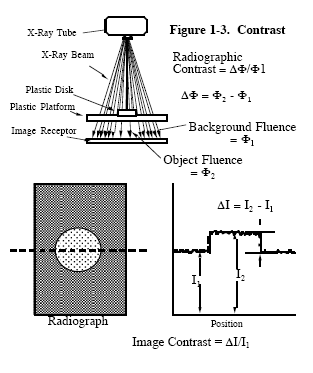

Goto: Calculate Output Format Notes
![]()
![]()
| Select Format: | Scientific | Engineering | Fixed |
![]()
| Definitions of contrast and diagram below from "The Physics of Medical X-Ray Imaging", 2nd Ed Author: Bruce H. Hasegawa, Ph.D.. Note also that the sign of the contrast is usually ignored. |

| In this case, F is proportional to f(x), so that F1 corresponds to f(0) and F2 to f(w*(1+Mph)), assuming that the slits are resolved. | |
| The image contrast cannot be determined without knowing the proportionality constant between F and OD of the film. | |
| It can be shown that the three equal max. values on film occur at x=0, ±2w*(1+Mph) and the two equal min. values at x=±w*(1+Mph), assuming the slits are resolved. | |
| If the slits are not resolved the film profile will appear as two peaks (or even one) instead of the expected three. | |
| The slit pitch equals 1/(2*w) and is usually expressed in line-pairs per millimeter. | |
| The radiographic magnification equals 1+m. | |
| Since the source is a disk, the line spread function is a circular: l(x)=sqrt(r^2-x^2) for |x|<r and 0 otherwise and r=D/2. | |
| The edge spread function is the integral of the line spread function: e(x)=x*sqrt(r^2-x^2)+r^2*arcsin(x/r)+r^2*pi/2. | |
| The resultant on the film plane is f(x)=e((w/2)*(1+m)-x) -e((-w/2)*(1+m)-x) +e((3w/2)*(1+m)-x) -e((5w/2)*(1+m)-x) +e((-3w/2)*(1+m)-x) -e((-5w/2)*(1+m)-x). |
Copyright ©2006 Raymond J. Allen